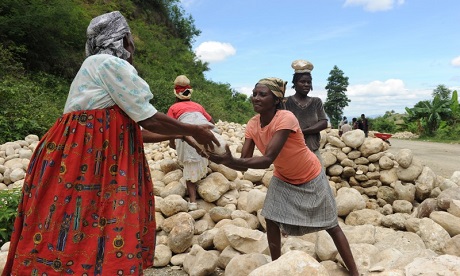The Temporary Protection Status (TPS) the United States granted Haitian people after an earthquake devastated the island nation in 2010 has been removed.
About 200,000 people died in the 7.0 magnitude quake which displaced over a million others.
Removing the TPS will affect between 50,000 and 60,000 people who sought refuge in the United States (US).
The US is giving the Haitians until July 2019 to leave the country.
Ashley Feasley, who is the Director of the Migration Policy and Public Affairs at the US Conference of Catholic Bishops, says the Bishops are “extremely concerned about what’s going to happen to these individuals and their families.”
Many Haitians have built new lives in the US.
About 6,200 have mortgages and 27,000 have US-born children.
The TPS policy allows people, who are unable to live safely or return home because of issues like armed conflict and natural disasters, to stay in the US while the situation in their home country resolves.
The US feels the situation in Haiti has improved enough for the TPS refugees to go home.
“Significant steps have been taken to improve the stability and quality of life for Haitian citizens, and Haiti is able to safely receive traditional levels of returned citizens,” Homeland Security secretary Elaine Duke says.
“Haiti has also demonstrated a commitment to adequately prepare for when the country’s TPS designation is terminated.”
The opposite view is held by David Quinn, a Catholic missionary who has lived in Haiti for the past two years.
Whether Haiti is able to support an influx of 60,000 people is a question that hasn’t been resolved, he claims.
He says Haiti has not recovered from the earthquake or from the Category 5 Hurricane Matthew which further devastated the country a year ago.
In his view, Haiti is ill-equipped to provide for the people who already live there, let alone the tens of thousands who left seven years ago.
“They have never recovered from the earthquake from what I can see,” Quinn says.
“They’ve cleaned up some things here and there, but as far as returning to what they had before? Not even close. Their economy hasn’t improved since the earthquake, it’s been continuing to degrade, and many, many people are without work yet.”
Quinn says in Port-au-Prince, Haiti’s capital, people are still living in “tents and tin boxes”.
He points out that most people subsist off a “pittance of an income and a really poor diet.”
Unemployment is already high and adding a further 60,000 people to the mix is going to cause further difficulty.
“How are they going to feed themselves?” he wonders.
He notes the government was not prepared to handle the earthquake’s aftermath and did little to help its own people.
Most work to improve living conditions has been done by non-profit and charitable organisations, he says.
Source
Additional readingNews category: World.




